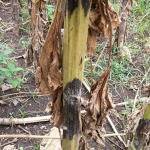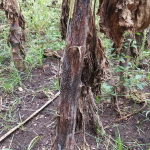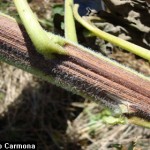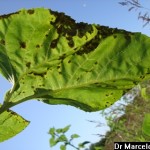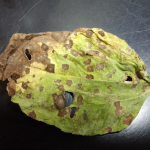.
Condición fitosanitaria: Presente
Grupo de cultivos: Oleaginosas
Especie hospedante: Girasol (Helianthus annuus)
Etiología: Complejo Fúngico. Hongos Necrotróficos (Hemibiotróficos)
Agente causal: Es un complejo integrado por diferentes patógenos:
* Alternaria helianthi (Hansf.) Tubaki & Nishihara, causante de la mancha de la hoja (MHA). Reclasificación en Alternariaster helianthi (Alves et al., 2013).
* Septoria helianthi Ellis & Kellerm., causante de la mancha de la hoja
* Phomopsis helianthi (teleomorph: Diaporthe helianthi) Munt.-Cvet. et al., causante del del cancro de tallo
* Phoma macdonaldii Boerema (teleomorph: Leptosphaeria lindquistii), Phoma oleracea var. helianthi-tuberosi. Sacc., causantes de la mancha negra del tallo (MNT). Reclasificación en Plenodomus lindquistii (de Gruyter et al., 2012)
.
.
.
Síntomatología
Los síntomas típicos de la MNT se ven en la zona de inserción del pecíolo con el tallo, formando manchas negras oscuras con márgenes definidos. Las manchas pueden eventualmente rodear el tallo. Por su parte los síntoma iniciales de la MHA son pequeños puntos necróticos (3-5 mm) castaños a negros en las hojas. Estas lesiones se caracterizan por ser circulares de bordes irregulares que van creciendo hasta unirse entre ellas, formando finalmente extensas áreas necróticas en la hoja. En general ambas enfermedades se manifiestan en floración y llenado de granos, o sea fin del ciclo de girasol y su presencia temprana ha generado dudas en el control de la misma.
.
Epidemiología
Todos son parásitos necrotróficos y su inoculo primario se encuentra en rastrojos de cultivos anteriores, semillas o plantas voluntarias. Se observan mas comúnmente en lotes implantados en SD sobre girasol (monocultivo) con presencia de rastrojo en superficie, posterior a días con lluvias y baja heliofanía efectiva.
.
Las Medidas de Manejo Integrado incluyen
- Rotación de cultivos con hospedantes no susceptibles.
- Siembras tempranas.
- Control de malezas hospedantes o girasoles guachos.
- Fungicidas foliares. No se conocen en Argentina suficientes ensayos con medidas de control químico y momentos de aplicación más oportunos. Se menciona en algunos casos pulverizaciones a partir del inicio de formación de botón floral con estrobilurinas y triasoles.
.
.
Bibliografía
Alves JL, Woudenberg JH, Duarte LL, Crous PW, Barreto RW (2013) Reappraisal of the genus Alternariaster (Dothideomycetes). Persoonia 31: 77-85. doi: 10.3767/003158513X669030
Bai Jianyu, Xu Biao, Duan Canxing, Guo Qingyuan, Wang Xiaoming (2012) Identification of Phoma macdonaldii Boerema causing black stem of sunflower in China. Canadian Journal of Plant Pathology 34(3): 459-462. doi: 10.1080/07060661.2012.709883
Bordat A, Marchand G, Langlade NB, Pouilly N, Muños S, Dechamp-Guillaume G, Vincourt P, Bret-Mestries E (2017) Different genetic architectures underlie crop responses to the same pathogen: the {Helianthus annuus * Phoma macdonaldii} interaction case for black stem disease and premature ripening. BMC Plant Biology 17: 167. doi: 10.1186/s12870-017-1116-1
de Gruyter J, Woudenberg JHC, Aveskamp MM, Verkley GJM, Groenewald JZ, Crous PW (2012) Redisposition of Phoma-like anamorphs in Pleosporales. Studies in Mycology. doi: 10.3114/sim0004
Larfeil C, Barrault G, Dechamp-Guillaume G (2010) Assessment of sunflower genotype tolerance to Phoma macdonaldii. Oilseeds & fats, Crops and Lipids 17(3): 161–166. doi: 10.1051/ocl.2010.0304
Mathew FM, Alananbeh KM, Jordahl JG, Meyer SM, Castlebury LA, Gulya TJ, Markell SG (2015) Phomopsis stem canker: A reemerging threat to sunflower (Helianthus annuus) in the United States. Phytopathology 105: 990-997. doi: 10.1094/PHYTO-11-14-0336-FI
Mathew FM, Rashid KY, Gulya TJ, Markell SG (2015) First Report of Phomopsis Stem Canker of Sunflower (Helianthus annuus) Caused by Diaporthe gulyae in Canada. Plant Disease 99(1): 160. doi: 10.1094/PDIS-08-14-0858-PDN
Moschini RC, Rodríguez MJ, Martínez MI, et al. (2019) Weather-based predictive models for Diaporthe helianthi ascospore release in Uruguay. Australasian Plant Pathology 48: 519–527. doi: 10.1007/s13313-019-00655-x
Olson T, Kontz B, Markell SG, Gulya TJ, Mathew FM (2015) First Report of Diaporthe stewartii causing Phomopsis Stem Canker of Sunflower (Helianthus annuus) in Minnesota. Plant Disease 101(2): 382. doi: 10.1094/PDIS-08-16-1122-PDN
Rajender J, Pushpavathi B, Santha Lakshmi Prasad M, Naresh N (2013) Cultural, Morphological and Pathogenic Characterization of Isolates of Alternaria helianthi Causing Sunflower Blight. Indian Journal of Plant Protection 41(1): 76-84. Online ISSN: 2249-7870
Robeson DJ, Strobel GA (1982) Deoxyradicinin, a novel phytotoxin from Alternaria helianthi. Phytochemistry 21(7): 1821-1823. doi: 10.1016/S0031-9422(82)85081-4
Roustaee A, Costes S, Dechamp-Guillaume G, Barrault G (2000) Phenotypic variability of Leptosphaeria lindquistii (anamorph: Phoma macdonaldii), a fungal pathogen of sunflower. Plant Pathology 49(2): 227-234. doi: 10.1046/j.1365-3059.2000.00451.x
Singh R, Ferrin DM (2012) First Report of Stem and Foliar Blight of Sunflower Caused by Alternariaster helianthi in Louisiana. Plant Disease 96(5): 761. doi: 10.1094/PDIS-01-12-0107-PDN
Thompson SM, Tan YP, Young AJ, et al. (2011) Stem cankers on sunflower (Helianthus annuus) in Australia reveal a complex of pathogenic Diaporthe (Phomopsis) species. Persoonia 27: 80–89. doi: 10.3767/003158511X617110
Wang T, Zhao J, Sun P, Wu X (2014) Characterization of Alternaria species associated with leaf blight of sunflower in China. European Journal of Plant Pathology 140(2): 301–315. doi: 10.1007/s10658-014-0464-z
